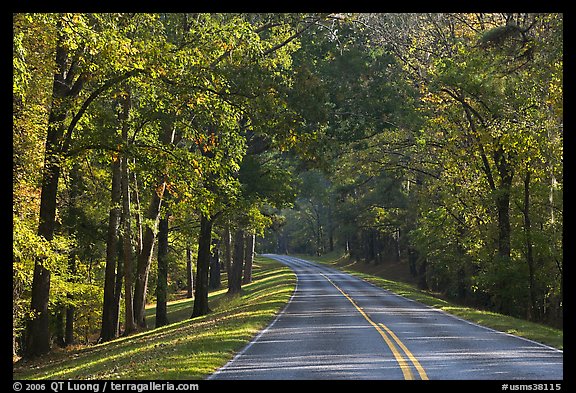Natchez Trace
The Natchez Trace is a 440-mile-long path extending from Natchez, Mississippi to Nashville, Tennessee.
It was used extensively by Native Americans and early European explorers as both a trade and transit route in the late 1700's and early 1800's.
Today, the trail has been commemorated with the 444-mile-long Natchez Trace Parkway which follows the approximate path of the trace. The trail itself has a long and rich history, filled with brave explorers, dastardly outlaws and daring settlers. Parts of the original trail are still accessible.
I remember driving through Natchez Trace in the winter; van and giant trailer in tow. It was very cold and snow quiet. Real early. Must've had a long drive to god knows where.
Most of the dudes in the van were sleeping save for Double R and I up front at the helm. Just then Mungo Jerry's "In The Summertime" came on my iPod and it was perfect.
Despite its brief lifespan, the Trace served an essential function in the years it was in existence. It was the only reliable and most expedient link between the goods of the North and the trading ports of Louisiana. This brought all sorts of people down the Trace: itinerant preachers, highwaymen and traders were just a few.
Many early footpaths were created by the wanderings of bison, deer and other game. In the case of the Trace, bison travelled north to find salt licks in the Nashville area.
After Native Americans first began to settle the land, they began to blaze the trail further, until it became a relatively, for the time, well-worn path traversable by horse in single-file.
The first recorded European Explorer to travel the Trace in its entirety was an unnamed Frenchman in 1742, who wrote of the trail and its "miserable conditions", though it may have been traveled in part before, particularly by famed Spanish explorer Hernando de Soto.
For early European explorers the assistance of Native Americans—specifically, the Cherokee, Choctaw and Chickasaw— proved vital. In fact, the aforementioned tribes facilitated trade among themselves along the Trace.
Meriwether Lewis, of the Lewis and Clark Expedition fame, met his mysterious end while traveling on the Trace. Lewis had stopped at Grinder's Stand near current-day Hohenwald Tennessee for rest.
Extremely depressed by the state of his financial affairs (he was deeply in debt), he became drunk as he had many times during the trip. He asked the owner of the stand for gunpowder, which she gave him, intimidated by his behavior. A few hours later, two shots rang out in the night—Lewis had apparently shot himself twice (highly improbable, given the difficulty of reloading muzzle-loading firearms, especially after being wounded), once in the head and once in the chest. He lived until the next morning.
His death went unquestioned as a suicide for many years. However, as time passed, more details emerged—had he also been stabbed? Had one of his rivals, particularly Robert Grinder, owner of the stand, killed and robbed him? Or was it a more politically motivated killing, an assassination against the governor of the Louisiana Territory?



No comments:
Post a Comment